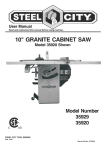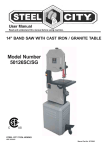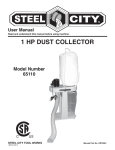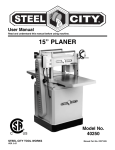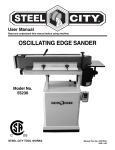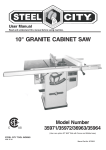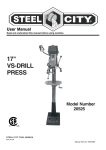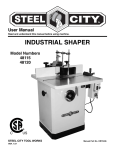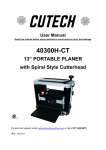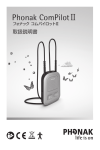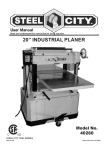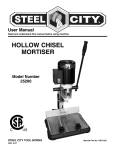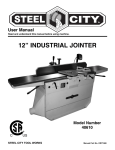Download 40620 - 8" Deluxe Jointer - Steel City Tool Works
Transcript
User Manual Read and understand this manual before using machine. 8” DELUXE JOINTER Model Number 40620 ® C US STEEL CITY TOOL WORKS Manual Part No. OR72075 w Steel City sted, and inspected te , ed gn si de en be s ha r Jointer. This jointe ly used and er op pr n he W d. in m in , with you, the customer u with years of yo e id ov pr ill w r te in jo maintained, your by one of the ed ck ba is it hy w is ch trouble free service, whi s in the business. ie nt ra ar w ry ne hi ac m t longes e Steel City’s th in ts uc od pr y an m of This jointer is just one is proof of our d an ry ne hi ac m ng ki or family of woodw omer satisfaction. commitment to total cust cellence each and ex r fo ve ri st to ue in nt co At Steel City we customer. For r ou u, yo of n io in op e every day and value th ity Tool Works, please C l ee St or r te in jo ur yo comments about tytoolworks.com . ci el te .s w w w at te si eb visit our w rchasing your ne pu r fo U O Y K N A H T 2 TABLE OF CONTENTS INTRODUCTION SECTION 1 Warranty .................................................................................................................................................4 SECTION 2 Product Specifications ............................................................................................................................7 SECTION 3 Accessories and Attachments ................................................................................................................7 SECTION 4 Definition of Terms ..................................................................................................................................8 SECTION 5 Feature Identification ..............................................................................................................................9 SECTION 6 General Safety......................................................................................................................................10 SECTION 7 Product Safety ......................................................................................................................................12 SECTION 8 Electrical Requirements........................................................................................................................13 SECTION 9 Unpacking & Inventory..........................................................................................................................15 SECTION 10 Assembly ..............................................................................................................................................18 SECTION 11 Adjustments ..........................................................................................................................................24 SECTION 12 Operations ............................................................................................................................................26 SECTION 13 Maintenance .........................................................................................................................................29 SECTION 14 Troubleshooting ....................................................................................................................................30 SECTION 15 Parts List...............................................................................................................................................33 INTRODUCTION This user manual is intended for use by anyone working with this machine. It should be kept available for immediate reference so that all operations can be performed with maximum efficiency and safety. Do not attempt to perform maintenance or operate this machine until you have read and understand the information contained in this manual. The drawings, illustrations, photographs, and specifications in this user manual represent your machine at time of print. However, changes may be made to your machine or this manual at any time with no obligation to Steel City Tool Works. 3 WARRANTY STEEL CITY TOOL WORKS 5 YEAR LIMITED WARRANTY Steel City Tool Works, LLC (“SCTW”) warrants all “STEEL CITY TOOL WORKS” machinery to be free of defects in workmanship and materials for a period of 5 years from the date of the original retail purchase by the original owner. SCTW will repair or replace, at its expense and at its option, any SCTW machine, machine part, or machine accessory which in normal use has proven to be defective, provided that the customer returns the product, shipping prepaid, to an authorized service center with proof of purchase and provides SCTW with a reasonable opportunity to verify the alleged defect by inspection. This warranty does not apply to defects due directly or indirectly to misuse, abuse, negligence, accidents, or lack of maintenance, or to repairs or alterations made or specifically authorized by anyone other than SCTW. Normal wear components are also excluded under this coverage. Every effort has been made to ensure that all SCTW machinery meets the highest quality and durability standards. We reserve the right to change specifications at any time due to our commitment to continuous improvement of the quality of our products. EXCEPT AS SET FORTH ABOVE, SCTW MAKES NO EXPRESS OR IMPLIED REPRESENTATIONS OR WARRANTIES WITH RESPECT TO ITS MACHINERY, OR ITS CONDITION, MERCHANTABILITY, OR FITNESS FOR ANY PARTICULAR PURPOSE OR USE. SCTW FURNISHES THE ABOVE WARRANTIES IN LIEU OF ALL OTHER WARRANTIES, EXPRESS OR IMPLIED, INCLUDING THE WARRANTIES OF MERCHANTABILITY AND FITNESS FOR A PARTICULAR PURPOSE, WHICH ARE HEREBY SPECIFICALLY DISCLAIMED. SCTW SHALL NOT BE LIABLE FOR ANY (A) SPECIAL, INDIRECT, INCIDENTAL, PUNITIVE OR CONSEQUENTIAL DAMAGES, INCLUDING WITHOUT LIMITATION LOSS OF PROFITS, ARISING FROM OR RELATED TO THIS WARRANTY, THE BREACH OF ANY AGREEMENT OR WARRANTY, OR THE OPERATION OR USE OF ITS MACHINERY, INCLUDING WITHOUT LIMITATION DAMAGES ARISING FROM DAMAGE TO FIXTURES, TOOLS, EQUIPMENT, PARTS OR MATERIALS, DIRECT OR INDIRECT LOSS CAUSED BY ANY OTHER PARTY, LOSS OF REVENUE OR PROFITS, FINANCING OR INTEREST CHARGES, AND CLAIMS BY ANY THIRD PERSON, WHETHER OR NOT NOTICE OF SUCH POSSIBLE DAMAGES HAS BEEN GIVEN TO SCTW; (B) DAMAGES OF ANY KIND FOR ANY DELAY BY OR FAILURE OF SCTW TO PERFORM ITS OBLIGATIONS UNDER THIS AGREEMENT; OR (C) CLAIMS MADE A SUBJECT OF A LEGAL PROCEEDING AGAINST SCTW MORE THAN ONE (1) YEAR AFTER SUCH CAUSE OF ACTION FIRST AROSE. The validity, construction and performance of this Warranty and any sale of machinery by SCTW shall be governed by the laws of the Commonwealth of Pennsylvania, without regard to conflicts of laws provisions of any jurisdiction. Any action related in any way to any alleged or actual offer, acceptance or sale by SCTW, or any claim related to the performance of any agreement including without limitation this Warranty, shall take place in the federal or state courts in Allegheny County, Pennsylvania. STEEL CITY TOOL WORKS 4 WARRANTY CARD Name ________________________________________________ Street _______________________________________________ Apt. No. ______________________________________________ City _________________________ State ______ Zip __________ Phone Number_________________________________________ E-Mail ________________________________________________ The following information is given on a voluntary basis and is strictly confidential. Where did you purchase your STEEL CITY machine? Store: ____________________________________________ City:______________________________________________ 2. How did you first learn of Steel City Tool Works? ___ Advertisement ___ Mail Order Catalog ___ Web Site ___ Friend ___ Local Store ✁ CUT HERE 3. ___ ___ ___ ___ ___ ___ Journal of Light Construction Popular Mechanics Popular Woodworking WOOD WOODEN Boat Woodsmith ___ Woodworker ___ Workbench 4. 5. 6. 7. do you subscribe to? ___ American How-To ___ Family Handyman ___ Fine Woodworking ___ Miter Saw ___ Palm Sander ___ Orbital Sander ___ Portable Thickness Planer ___ Saber Saw ___ Router ___ Reciprocating Saw Other_______________________ 13. What machines / accessories would you like to see added to the STEEL CITY line? ____________________________________________________ Which of the following woodworking / remodeling shows do you watch? ___ Backyard America ___ The American Woodworker ___ Home Time ___ The New Yankee Workshop ___ This Old House ___ Woodwright’s Shop Other__________________________________________ What is your age group? ___ 20 to 29 years ___ 40 to 49 years ___ 60 to 69 years How many Steel City machines do you own? _____________ 12. Which portable / hand held power tools do you own? Check all that apply. ___ Belt Sander ___ Biscuit Jointer ___ Dust Collector ___ Circular Saw ___ Detail Sander ___ Drill / Driver ___ Old House Journal ___ Popular Science ___ Today’s Homeowner ___ Woodcraft ___ Woodshop News ___ Woodwork ___ Woodworker’s Journal Other_________________ What is your annual household ___ $20,000 to $29,999 ___ $40,000 to $49,999 ___ $60,000 to $69,999 ___ $80,000 to $89,999 9. 11. Which benchtop tools do you own? Check all that apply. ___ Belt Sander ___ Belt / Disc Sander ___ Drill Press ___ Band Saw ___ Grinder ___ Mini Jointer ___ Mini Lathe ___ Scroll Saw ___ Spindle / Belt Sander Other______________________ Other_______________________ Which of the following magazines ___ American Woodworker ––– Cabinetmaker ___ Fine Homebuilding How would you rank your woodworking skills? ___ Simple ___ Intermediate ___ Advance ___ Master Craftsman 10. What stationary woodworking tools do you own? Check all that apply. ___ Air Compressor ___ Band Saw ___ Drill Press ___ Drum Sander ___ Dust Collection ___ Horizontal Boring Machine ___ Jointer ___ Lathe ___ Mortiser ___ Panel Saw ___ Planer ___ Power Feeder ___ Radial Arm Saw ___ Shaper ___ Spindle Sander ___ Table Saw ___ Vacuum Veneer Press ___ Wide Belt Sander Other____________________________________________ Product Description:_____________________________________ Model No.: ___________________________________________ Serial No. _____________________________________________ 1. 8. ____________________________________________________ 14. What new accessories would you like to see added? ____________________________________________________ ____________________________________________________ income? ___ $30,000 to $39,999 ___ $50,000 to $59,999 ___ 70,000 to $79,999 ___ $90,000 + 15. Do you think your purchase represents good value? ___ No ___Yes 16. Would you recommend STEEL CITY products to a friend? ___ No ___ Yes ___ 30 to 39 years ___ 50 to 59 years ___ 70 + years 17. Comments: ____________________________________________________ ____________________________________________________ ____________________________________________________ ____________________________________________________ ____________________________________________________ How long have you been a woodworker? ___ 0 to 2 years ___ 2 to 8 years ___ 8 to 20 years ___ over 20 years 5 FOLD ON DOTTED LINE PLACE STAMP HERE Steel City Tool Works P.O. Box 10529 Murfreesboro, TN 37129 FOLD ON DOTTED LINE 6 PRODUCT SPECIFICATIONS Motor Specifications: Product Dimensions: Type TEFC Induction, Ball Bearing Continuous Duty Horsepower 2 HP Amps 7.5 Voltage 230 Phase Single Hertz 60 RPM 3450 (no load) Footprint 24” x 17-1/2” Length 75-1/2” Width 23-1/2” Height 42” Total Net Weight 447 lbs with stand Shipping Dimensions: JOINTER Product Specifications: Table 8” x 75-1/2” Number of Knives 3 Cutterhead Diameter 3-1/8” Cutterhead Speed 5,000 RPM Cuts per Minute 15,000 Knife Adjustment Quick-change Fence Size Overall 5-1/2” x 48” Maximum Depth of cut 1/2” Maximum Depth of rabbet 1/2” Carton Type Wooden Crate Length 78” Width 27” Height 17-1/2” Gross Weight 429 STAND Carton type Cardboard Box Length 26” Width 23-1/2” Height 17-1/2” Gross Weight 134 ACCESSORIES AND ATTACHMENTS There are a variety of accessories available for your Steel City Product. For more information on any accessories associated with this and other machines, please contact your nearest Steel City distributor, or visit our website at: www.steelcitytoolworks.com. 7 DEFINITION OF TERMS Edge Jointing: The process of making the edge of a piece of stock straight and square Rabbet: A rectangular cut or groove along or near the edge of a piece of wood that allows another piece to fit into it to form a joint Face Jointing: Similar to edge jointing except rather then the edge it is the face of the board that is being machined flat and square. Snipe: Gouging or depression of the board at the ends. Snipe can occur either at the beginning of the board going into the jointer or at the end of the board as it comes out of the jointer. Gum, Pitch or Resin: A sticky sap based residue that comes from wood products. 8 FEATURE IDENTIFICATION B D C A E K F I G J H A) Outfeed Table G) Depth Scale B) Fence H) Infeed Table Lock Handle C) Cutterhead Guard I) Outfeed Table Lock Handle D) Power Switch J) Dust Port E) Infeed Table K) Outfeed Table Raise/Lower Handwheel F) Infeed Table Raise/Lower Handwheel 9 GENERAL SAFETY ! WARNING ! WARNING TO AVOID serious injury and damage to the machine, read and follow all Safety and Operating Instructions before assembling and operating this machine. This manual is not totally comprehensive. It does not and can not convey every possible safety and operational problem which may arise while using this machine. The manual will cover many of the basic and specific safety procedures needed in an industrial environment. Exposure to the dust created by power sanding, sawing, grinding, drilling and other construction activities may cause serious and permanent respiratory or other injury, including silicosis (a serious lung disease), cancer, and death. Avoid breathing the dust, and avoid prolonged contact with dust. The dust may contain chemicals known to the State of California to cause cancer, birth defects or other reproductive harm. All federal and state laws and any regulations having jurisdiction covering the safety requirements for use of this machine take precedence over the statements in this manual. Users of this machine must adhere to all such regulations. Some examples of these chemicals are: • Lead from lead-based paints. Below is a list of symbols that are used to attract your attention to possible dangerous conditions. • Crystalline silica from bricks, cement and other masonry products. • Arsenic and chromium from chemically-treated lumber. ! This is the safety alert symbol. It is used to alert you to potential personal injury hazards. Obey all safety messages that follow this symbol to avoid possible injury or death. ! Always operate tool in well ventilated area and provide for proper dust removal. Use a dust collection system along with an air filtration system whenever possible. Always use properly fitting NIOSH/OSHA approved respiratory protection appropriate for the dust exposure, and wash exposed areas with soap and water. DANGER Indicates an imminently hazardous situation which, if not avoided, WILL result in death or serious injury. ! 1. To avoid serious injury and damage to the machine, read the entire User Manual before assembly and operation of this machine. WARNING Indicates a potentially hazardous situation which, if not avoided, COULD result in death or serious injury. ! CAUTION ! WARNING Indicates a potentially hazardous situation, if not avoided, MAY result in minor or moderate injury. It may also be used to alert against unsafe practices. CAUTION 2. ALWAYS wear eye protection. Any machine can throw debris into the eyes during operations, which could cause severe and permanent eye damage. Everyday eyeglasses are NOT safety glasses. ALWAYS wear Safety Goggles (that comply with ANSI standard Z87.1) when operating power tools. CAUTION used without the safety alert symbol indicates a potentially hazardous situation which, if not avoided, may result in property damage. NOTICE This symbol is used to alert the user to useful information about proper operation of the machine. 10 ! 11. DO NOT FORCE the machine to perform an operation for which it was not designed. It will do a safer and higher quality job by only performing operations for which the machine was intended. WARNING 12. DO NOT stand on a machine. Serious injury could result if it tips over or you accidentally contact any moving part. 3. ALWAYS wear hearing protection. Plain cotton is not an acceptable protective device. Hearing equipment should comply with ANSI S3.19 Standards. ! 13. DO NOT store anything above or near the machine. 14. DO NOT operate any machine or tool if under the influence of drugs, alcohol, or medication. WARNING 15. EACH AND EVERY time, check for damaged parts prior to using any machine. Carefully check all guards to see that they operate properly, are not damaged, and perform their intended functions. Check for alignment, binding or breakage of all moving parts. Any guard or other part that is damaged should be immediately repaired or replaced. 4. ALWAYS wear a NIOSH/OSHA approved dust mask to prevent inhaling dangerous dust or airborne particles. 16. Ground all machines. If any machine is supplied with a 3-prong plug, it must be plugged into a 3contact electrical receptacle. The third prong is used to ground the tool and provide protection against accidental electric shock. DO NOT remove the third prong. 5. ALWAYS keep the work area clean, well lit, and organized. DO NOT work in an area that has slippery floor surfaces from debris, grease, and wax. 6. ALWAYS unplug the machine from the electrical receptacle when making adjustments, changing parts or performing any maintenance. 17. Keep visitors and children away from any machine. DO NOT permit people to be in the immediate work area, especially when the machine is operating. 7. AVOID ACCIDENTAL STARTING. Make sure that the power switch is in the “OFF” position before plugging in the power cord to the electrical receptacle. ! 18. KEEP protective guards in place and in working order. 19. MAINTAIN your balance. DO NOT extend yourself over the tool. Wear oil resistant rubber soled shoes. Keep floor clear of debris, grease, and wax. WARNING 20. MAINTAIN all machines with care. ALWAYS KEEP machine clean and in good working order. KEEP all blades and tool bits sharp. 8. AVOID a dangerous working environment. DO NOT use electrical tools in a damp environment or expose them to rain or moisture. ! 21. NEVER leave a machine running, unattended. Turn the power switch to the OFF position. DO NOT leave the machine until it has come to a complete stop. 22. REMOVE ALL MAINTENANCE TOOLS from the immediate area prior to turning the machine ON. WARNING 23. SECURE all work. When it is possible, use clamps or jigs to secure the workpiece. This is safer than attempting to hold the workpiece with your hands. 9. CHILDPROOF THE WORKSHOP AREA by removing switch keys, unplugging tools from the electrical receptacles, and using padlocks. 24. STAY ALERT, watch what you are doing, and use common sense when operating any machine. DO NOT operate any machine tool while tired or under the influence of drugs, alcohol, or medication. A moment of inattention while operating power tools may result in serious personal injury. 10. DO NOT use electrical tools in the presence of flammable liquids or gasses. 11 25. USE ONLY recommended accessories. Use of incorrect or improper accessories could cause serious injury to the operator and cause damage to the machine. If in doubt, DO NOT use it. 3. Prevent electrical shock. Follow all electrical and safety codes, including the National Electrical Code (NEC) and the Occupational Safety and Health Regulations (OSHA). All electrical connections and wiring should be made by qualified personnel only. 26. THE USE of extension cords is not recommended for 230V equipment. It is better to arrange the placement of your equipment and the installed wiring to eliminate the need for an extension cord. If an extension cord is necessary, refer to the chart in the Grounding Instructions section to determine the minimum gauge for the extension cord. The extension cord must also contain a ground wire and plug pin. ! WARNING 4. TO REDUCE the risk of electrical shock. DO NOT use this machine outdoors. DO NOT expose to rain or moisture. Store indoors in a dry area. 27. Wear proper clothing, DO NOT wear loose clothing, gloves, neckties, or jewelry. These items can get caught in the machine during operations and pull the operator into the moving parts. Users must wear a protective cover on their hair, if the hair is long, to prevent it from contacting any moving parts. 5. STOP using this machine, if at any time you experience difficulties in performing any operation. Contact your supervisor, instructor or machine service center immediately. 28. SAVE these instructions and refer to them frequently and use them to instruct other users. 6. Safety decals are on this machine to warn and direct you to how to protect yourself or visitors from personal injury. These decals MUST be maintained so that they are legible. REPLACE decals that are not legible. 29. Information regarding the safe and proper operation of this tool is also available from the following sources: Power Tool Institute 1300 Summer Avenue Cleveland, OH 44115-2851 www.powertoolinstitute.org 7. DO NOT leave the unit plugged into the electrical outlet. Unplug the unit from the outlet when not in use and before servicing, performing maintenance tasks, or cleaning. National Safety Council 1121 Spring Lake Drive Itasca, IL 60143-3201 8. ALWAYS turn the power switch “OFF” before unplugging the jointer. American National Standards Institute 25 West 43rd Street, 4th floor New York, NY 10036 www.ansi.org ! ANSI 01.1 Safety Requirements for Woodworking Machines, and the U.S. Department of Labor regulations www.osha.gov WARNING 9. DO NOT handle the plug or jointer with wet hands. 10. USE accessories only recommended by Steel City. PRODUCT SAFETY 11. DO NOT pull the jointer by the power cord. NEVER allow the power cord to come in contact with sharp edges, hot surfaces, oil or grease. 1. Serious personal injury may occur if normal safety precautions are overlooked or ignored. Accidents are frequently caused by lack of familiarity or failure to pay attention. Obtain advice from supervisor, instructor, or another qualified individual who is familiar with this machine and its operations. 12. DO NOT unplug the jointer by pulling on the power cord. ALWAYS grasp the plug, not the cord. 13. REPLACE a damaged cord immediately. DO NOT use a damaged cord or plug. If the jointer is not operating properly, or has been damaged, left outdoors or has been in contact with water. 2. Every work area is different. Always consider safety first, as it applies to your work area. Use this machine with respect and caution. Failure to do so could result in serious personal injury and damage to the machine. 14. DO NOT use the jointer as a toy. DO NOT use near or around children. 12 15. ENSURE that the machine sits firmly on the floor before using. If the machine wobbles or is unstable, correct the problem by using shims or blocks prior to operation. 21. NEVER remove any chips without turning off the machine and disconnecting the power. 22. NEVER turn on the machine if the workpiece is in contact with the cutterhead. 16. ALWAYS keep hands and fingers away from the blades when operating. 18. DO NOT use the jointer on pieces less than 10” in length. 23. ALWAYS feed against the rotation of the cutterhead. Never apply feed pressure with your hands directly over the cutterhead. Always lift your hands, one at a time, over the cutterhead as you pass the work along the jointer bed. Always support the workpiece and maintain control throughout the operation. 19. NEVER use the jointer with the depth of cut at more than 1/8”. 24. KEEP cutterhead knives sharp and free of all rust and pitch. 20. MAINTAIN the proper relationship between the infeed and outfeed tables and the cutterhead knives. 25. ALWAYS disconnect the machine from the power source before making any adjustments. 17. USE push blocks on any materials less than 3” in height or thickness. 26. NEVER perform “free hand” operations. Use the fence to position and guide the workpiece. ELECTRICAL REQUIREMENTS ! WARNING The switch provided with your jointer is designed for 230 volt single phase usage only. The switch has a plug that is designed to plug into a 230 volt outlet. There are many different configurations for 230 volt outlets, so it is conceivable that the configuration of the plug may not match the configuration of your existing outlet. If this is the case, you will have to replace the plug with a UL/CSA approved plug that matches the configuration of your 230V outlet. To reduce the risk of electric shock, follow all electrical and safety codes, including the National Electric Code (NEC) and the Occupational Safety and Health Regulations (OSHA). All electrical connections and wiring should be made by qualified personnel only. 13 GROUNDING INSTRUCTIONS ! The motor supplied with your machine is a 230 volt, 60 hertz, single phase motor. Never connect the green or ground wire to a live terminal. WARNING A machine with a 230 volt plug should only be connected to an outlet having the same configuration as the plug. This machine MUST BE GROUNDED while in use to protect the operator from electric shock. EXTENSION CORDS In the event of a malfunction or breakdown, GROUNDING provides the path of least resistance for electric current and reduces the risk of electric shock. The plug MUST be plugged into a matching electrical receptacle that is properly installed and grounded in accordance with ALL local codes and ordinances. ! To reduce the risk of fire or electrical shock, use the proper gauge of extension cord. When using an extension cord, be sure to use one heavy enough to carry the current your machine will draw. If a plug is provided with your machine DO NOT modify the plug. If it will not fit your electrical receptacle, have a qualified electrician install the proper connections to meet all electrical codes local and state. All connections must also adhere to all of OSHA mandates. The smaller the gauge-number, the larger the diameter of the extension cord is. If in doubt of the proper size of an extension cord, use a shorter and thicker cord. An undersized cord will cause a drop in line voltage resulting in a loss of power and overheating. IMPROPER ELECTRICAL CONNECTION of the equipment-grounding conductor can result in risk of electric shock. The conductor with the green insulation (with or without yellow stripes) is the equipment-grounding conductor. DO NOT connect the equipment-grounding conductor to a live terminal if repair or replacement of the electric cord or plug is necessary. ! CAUTION USE ONLY a 3-wire extension cord that has a 3-prong grounding plug and a 3-pole receptacle that accepts the machine’s plug. Check with a qualified electrician or service personnel if you do not completely understand the grounding instructions, or if you are not sure the tool is properly grounded. If you are using an extension cord outdoors, be sure it is marked with the suffix “W-A” (“W” in Canada) to indicate that it is acceptable for outdoor use. Make certain the extension cord is properly sized, and in good electrical condition. Always replace a worn or damaged extension cord immediately or have it repaired by a qualified person before using it. PLUGS/RECEPTACLES ! WARNING WARNING Protect your extension cords from sharp objects, excessive heat, and damp or wet areas. • Electrocution or fire could result if this machine is not grounded properly or if the electrical configuration does not comply with local and state electrical codes. • MAKE CERTAIN the machine is disconnected from power source before starting any electrical work. • MAKE SURE the circuit breaker does not exceed the rating of the plug and receptacle. MINIMUM RECOMMENDED GAUGE FOR EXTENSION CORDS (AWG) 230 VOLT OPERATION ONLY 14 25’ LONG 50’ LONG 100’ LONG 0 to 6 Amps 16 AWG 16 AWG 14 AWG 6 to 8 Amps 16 AWG 16 AWG 12 AWG 8 to 12 Amps 14 AWG 14 AWG 10 AWG 12 to 15 Amps 12 AWG 12 AWG 10 AWG 15 to 20 Amps 10 AWG 10 AWG Not recommended UNPACKING & INVENTORY ! of the parts and the jointer. The protective coatings can be removed by spraying WD-40 on them and wiping it off with a soft cloth. This may need to be redone several times before all of the protective coatings are removed completely. WARNING After cleaning, apply a good quality paste wax to any unpainted surfaces. Make sure to buff out the wax before assembly. • The machine is heavy, two people are required to unpack and lift. • Use a safety strap to avoid tip over when lifting machine. Compare the items to inventory figures; verify that all items are accounted for before discarding the shipping box. Check shipping carton and machine for damage before unpackaging. Carefully remove packaging materials, parts and machine from shipping carton. Always check for and remove protective shipping materials around motors and moving parts. Lay out all parts on a clean work surface. ! WARNING If any parts are missing, do not attempt to plug in the power cord and turn “ON” the machine. The machine should only be turned “ON” after all the parts have been obtained and installed correctly. For missing parts, contact Steel City at 1-877-SC4-TOOL. Remove any protective materials and coatings from all B D C A E A) Rear Panel B) Cutterhead Guard C) V-belts (2) D) Power Switch E) Dust Port 15 F) Table Adjusting Handwheels (2) G) Fence Adjusting Handwheel H) Handles F G H I) Jointer Base I 16 K L J M N O Q R J) Hex Wrenches (3) K) 1/4-20 x 1/2” Pan Head Screws (4) L) Open End Wrenches (2) M) M6 Flat Washer (4) N) M10 Lock Washer (3) O) 1/4-20 x 1/2” Socket Head Cap Screws (4) P) Strain Relief Bushing Q) M6 Lock Washers (4) R) Mounting Stud (3) 17 P ASSEMBLY MOUNTING JOINTER TO STAND ! 3. Align the 3 bolt holes located in the base of the jointer with the 3 holes in the stand. WARNING 4. Use the special mounting studs and M10 lock washers, 2 of which are shown in FIG 3, to secure the jointer to the stand. Tighten securely. SEE FIG 3. Fig. 3 • The machine is heavy, two people are required to unpack and lift. 1. Be sure the pulley on the motor is in line with the cutout (A) in the top of the stand so the drive belt can pass through. SEE FIG 1. Mounting Studs Fig. 1 A NOTE: The third mounting stud is accessible by reaching up through the hole in the top of the dust chute. ASSEMBLING BELT AND ALIGNING PULLEYS 1. Remove the cutterhead pulley guard (A) by unscrewing the knob (B) SEE FIG 4. Fig. 4 2. Using a helper, lift the jointer onto the stand. SEE FIG 2. Fig. 2 A B 18 ADJUSTING BELT TENSION 2. Place the V-belts onto the cutterhead pulley(C) SEE FIG 5. 1. Correct belt tension is obtained when there is approximately 1” deflection at the center span of the belt using light finger pressure. Fig. 5 2. If an adjustment is required, the motor can be raised or lowered to obtain the correct belt tension. 3. Tighten motor mounting hardware after tension is applied, making sure alignment of the pulleys is not disturbed. 4. Replace the cutterhead pulley guard. ASSEMBLING FENCE CARRIAGE ASSEMBLY C The fence carriage assembly is already installed on the jointer at the factory. You only need to take a few steps for the fence to be fully operational. D ! WARNING MAKE CERTAIN THAT THE MACHINE IS DISCONNECTED FROM THE POWER SOURCE. 1. The fence locking handle needs to be inverted for proper operation. To install properly unscrew the special nut (A) on the top of the fence and pull the locking handle (B) out the bottom of the fence. SEE FIG. 6. Fig. 6 3. Loosen the motor mounting bolts and raise the motor up until the belt fits around the motor pulley (D). 4. Using a straight edge, check that both pulleys are aligned in the same plane. If the pulleys are not in line, reposition the motor until the pulleys are aligned. A 5. Tighten the motor mounting bolts. Check the alignment of the pulleys once more to assure nothing has moved. B NOTICE: If alignment cannot be met by moving the motor in or out, loosen the motor pulley set screws and move pulley in or out on the shaft until proper alignment is achieved. ! WARNING The outside edge of the pulley must never be extended past the end of the motor shaft in any circumstance. 19 2. Insert the locking handle through the same hole, only this time make sure that the handle shaft goes through the top of the fence assembly as shown in FIG 7. SEE FIG 7. 4. Attach the fence adjusting handwheel (A) to the shaft (B) by aligning the grooves in the handwheel with the pin (C) in the shaft. SEE FIG 9. Fig. 9 Fig. 7 A C B 5. Fasten the handwheel to the shaft by tightening the set screw (D) using the provided hex wrench. SEE FIG 10. 3. Fasten the special nut, removed in step 1, to the bottom of the fence locking handle shaft. Make certain that the two prongs on the special nut face upwards and fit into the groove (C) on the bottom of the fence assembly. SEE FIG 8. Fig. 10 Fig. 8 D C 20 Fig. 12 ASSEMBLING CUTTERHEAD GUARD ! WARNING MAKE CERTAIN THAT THE MACHINE IS DISCONNECTED FROM THE POWER SOURCE. ! CAUTION The cutterhead guard has a tension return spring. The tension on this spring is set at the factory. When the guard is installed properly it should return to the fence automatically after the workpiece has passed over the cutterhead. Be sure the guard is functioning properly before using the jointer. C D 1. Move the fence all the way to the rear of the table exposing the cutterhead. 5. Tighten the set screw using the handle (D). 2. Rotate the cutterhead by hand ,using the belt, until there are no blades exposed. If this is not possible, place a thin piece of cardboard over the cutterhead. This is done to avoid exposure of hand to sharp blade. ! 6. Check guard clearance to be sure it is not dragging over table surface or cutterhead. If the guard is too low, loosen the set screw and raise the guard slightly. Test the guard and be sure it springs back to the fence when pulled out. Test with the fence in its furthest position from the guard. Make it a habit to check this important safety feature every time before using the jointer. CAUTION Care must be taken when your hands are near the knives as the cutting edges are very sharp. 3. Locate the mounting hole(A) on the right hand side of the rabbetting ledge. Check to make sure that the locking set screw(B) is not protruding into the mounting hole at this time. SEE FIG 11. ASSEMBLING DUST PORT 1. The jointer stand has a built in dust chute. If this machine is to be hooked up to a dust collection system, the supplied dust port can be fastened to the jointer stand using four 1/4-20 x 1/2” pan head screws and four flat washers. SEE FIG 13. Fig. 11 Fig. 13 A B 4. Place the guard above the table positioned over the cutterhead with curved edge against fence and drop the shaft in the hole. The pin (C) should be below the surface of the infeed table and pressed up against the side of the jointer. SEE FIG 12. 2. A standard 4” dust collection hose can now be attached to this port. NOTE: DO NOT ATTACH THE DUST PORT IF YOU DO NOT PLAN TO CONNECT THE JOINTER TO A DUST COLLECTION SYSTEM. 21 ATTACHING SWITCH 5. Remove the cap on the motor exposing the wire attachments. 1. Locate the 4 threaded holes on the back side of the infeed table. 6. Thread the wires through the strain relief bushing (A) and make your connections on the motor. Refer to FIG 16 to determine where each wire gets connected. SEE FIG 16. 2. Line up the four holes on the switch bracket (A) with the four threaded holes in the jointer. SEE FIG 14. Fig. 16 Fig. 14 CONNECT GROUND WIRE HERE A CONNECT WHITE LEAD HERE CONNECT BLACK LEAD HERE 3. Fasten using four 1/4-20 x 1/2” socket head cap screws and four lock washers. Tighten securely. 4. Insert the end of the wire with no plug on it into the base of the jointer. SEE FIG 15. A Fig. 15 NOTE: There is a set screw(B) located on the side of the strain relief bushing that you will need to loosen in order to fit the wires through. Once you have made all of your connections, retighten this set screw. SEE FIG 17. Fig. 17 B 22 7. Replace motor cap. 2. Remove the pan head screw and flat washer. Remove the tape from the key. 8. Wrap strain relief bushing (C) around the cord (D) and insert the strain relief bushing into the hole. SEE FIG 18. 3. Insert the handwheel onto the shaft making sure that the notch in the handwheel lines up with the key on the shaft. Fig. 18 4. Fasten the handwheel to the shaft using pan head screw and flat washer removed in step 2. 5. Thread the handle (D) into the threaded hole (E) in the handwheel. SEE FIG 20. Fig. 20 C E D D HANDWHEEL ASSEMBLY REAR ACCESS PANEL The purpose of the handwheels is to raise and lower the outfeed and infeed tables. The procedure for installation is the same for both the infeed and outfeed sides of the jointer. To install: The access panel needs to be installed on the rear of the jointer base. To install 1. Place the bottom edge of the access panel (A) on the lower edge of the jointer base. SEE FIG 21. 1. The key (A) pan head screw (B) and flat washer (C) should already be attached to the shaft. SEE FIG. 19. 2. Lift up the access panel and fasten shut using locking knob (B). Fig. 19 Fig. 21 A C B B 23 A ADJUSTMENTS INFEED TABLE ADJUSTMENTS OUTFEED TABLE ADJUSTMENTS ! WARNING To raise or lower the infeed table, loosen infeed table lock handle (B) and turn the table raising and lowering handwheel (A) until the table is at the desired position and tighten infeed table lock handle. SEE FIG. 22. DISCONNECT MACHINE FROM POWER SOURCE. The outfeed table must be exactly level with the knives when the knives are at their highest point of revolution. To move the outfeed table, loosen outfeed table lock handle (C) and turn the table raising and lowering handwheel (D) until the table is level with the knives. When the outfeed table is exactly level with the knives at their highest point of revolution, tighten outfeed table lock handle. SEE FIG. 22. Fig. 22 KNIFE ADJUSTMENTS ! CAUTION Care must be taken when handling the knives as the cutting edges are very sharp. D C B The quick change knives on your jointer are double sided and are mounted on special pins. These pins automatically set the knife at its proper height, eliminating the need for a knife gauge. While the knives on your jointer come preinstalled at the factory, the following procedures detail how to remove and install a set of knives. A INFEED POSITIVE STOP 1. Start in the center of the knife gib and remove the 4 mm allen head screw (A). SEE FIG 24. There is a safety feature that will not allow the infeed table to drop below a 1/8-in depth of cut. This stop (A) is located on the rear of the jointer. Once the jointer hits a depth of 1/8”, the spring loaded knob snaps into a hole in the infeed table. To make the infeed table go lower than this, you will have to pull out on the knob as you lower the table. SEE FIG 23. Fig. 24 A Fig. 23 A 2. Alternate sides as you loosen the remaining screws along the length of the gib 3. Remove the black knife gib. The knife below can now be lifted off of the (2) locating pins. 4. Flip the knife over if necessary to expose new edge and mount the knife back on the (2) locating pins. 5. Place the black knife gib over the knife with the angled side up and the angle in the same direction as the knife edge. 24 6. Line the outside edges of the knife up with each other. 7. Replace the (5) 4 MM Allen head screws and tighten from the center out alternating sides as you go. MAKE CERTAIN THAT THE ALLEN HEAD SCREWS ARE TIGHTENED ALL THE WAY INTO THE CUTTERHEAD. 4. Tilt the fence inward until it hits the 45 degree in stop nut (E). SEE FIG. 26. 8. Repeat this procedure for all three knives. Fig. 27 5. Using a combination square, check to see if the fence is indeed tilted in at 45 degrees. SEE FIG 27. ADJUSTING FENCE POSITIVE STOPS The fence on your jointer is equipped with positive stops at the most used fence positions of 90 degrees and 45 degrees in and out. To check and adjust the positive stops, proceed as follows: ! WARNING MAKE CERTAIN THAT THE MACHINE IS DISCONNECTED FROM THE POWER SOURCE. 1. Position the fence at 90 degrees to the table by loosening the bevel lock handle(A) and moving the fence until 90 degree stop screw (B) hits the stop (C). SEE FIG 25. Fig. 25 6. If an adjustment is necessary, tighten or loosen the stop nut (E) until the fence is at 45 degrees. 7. Tilt the fence outward to 45 degrees. To do this you will have to flip the 90 degree stop (C) out of the way so that it faces towards the infeed table. SEE FIG 25. D B C F 8. Using a combination square, check to see if the fence is tilted at 45 degrees. SEE FIG 28. A Fig. 28 2. Using a square, check to see if the fence is at 90 degrees to the table. 3. If the fence is not at 90 degrees, loosen nut (D) and adjust the stop screw (B) until the fence is at 90 degrees to the table. Retighten nut (D). Fig. 26 E 9. 25 If an adjustment is necessary, loosen or tighten stop screw (F) until the fence is at 45 degrees. SEE FIG 25. OPERATIONS According to many OSHA, ANSI, STATE, and LOCAL CODES, it is the Employers Responsibility to: ! WARNING • PERMIT ONLY trained and authorized employees to operate equipment. • INSPECT AND MAINTAIN guards, safety devices and start/stop controls. CHILDPROOF THE WORKSHOP AREA by removing switch keys, unplugging tools from the electrical receptacles, and using padlocks. • INSTRUCT, TRAIN and SUPERVISE the safe method of work. ! WARNING MOTOR OVERLOAD PROTECTION Serious personal injury may occur if normal safety precautions are overlooked or ignored. Accidents are frequently caused by lack of familiarity or failure to pay attention. Obtain advice from supervisor, instructor, or another qualified individual who is familiar with the machine and its operations. Your Jointer is supplied with an automatic thermal overload on the motor. If the motor shuts off or fails to start due to an overload condition, turn the Jointer “OFF,” let the motor cool for three to five minutes, The motor can then be turned on again in the usual manner. Every work area is different. Always consider safety first, as it applies to your work area. Use any machine with respect and caution. Failure to do so could result in serious personal injury and damage to the machine. PLACEMENT OF HANDS DURING FEEDING STOP using the machine, if at any time you experience difficulties in performing any operation. Contact your supervisor, instructor or machine service center immediately. At the start of the cut, the left hand holds the work firmly against the infeed table and fence, while the right hand pushes the work toward the knives. After the cut is underway, the new surface rests firmly on the outfeed table. The left hand should then be moved to the work on the outfeed table, at the same time maintaining flat contact with the fence. The right hand presses the work forward, and before the right hand reaches the cutterhead, it should be moved to the work on the outfeed table. START/STOP SWITCH The START/STOP switch assembly is located above the infeed table. To turn the jointer “ON”. push the green start button. To turn the jointer “OFF”, push the red stop button. SEE FIG. 29. ! Fig. 29 WARNING NEVER PASS HANDS DIRECTLY OVER THE CUTTERHEAD. DIRECTION OF GRAIN Avoid feeding work into the jointer against the grain. The result will be chipped and splintered edges. Feed with the grain to obtain a smooth surface. FENCE OPERATION The fence can be moved across the table by loosening the lock lever (A) and rotating the handwheel (B) . Turning the handwheel counterclockwise moves the fence towards the operator, while turning it clockwise moves the fence away from the operator. SEE FIG 30. page 27. 26 SURFACING Fig. 30 Surfacing is similar to the edge jointing operation except for the position of the workpiece. For surfacing, the major flat surface of the workpiece is placed on the infeed table of the jointer with the narrow edge of the workpiece against the fence, as shown in Fig. 32. The workpiece is moved from the infeed table, across the cutterhead to the outfeed table, establishing a flat surface on the workpiece. SEE FIG. 32. A B Fig. 32 JOINTING AN EDGE This is the most common operation for the jointer. These cuts are made to square an edge of a workpiece. Set the guide fence square with the table. Depth of cut should be the minimum required to obtain a straight edge. Hold the best face of the piece firmly against the fence throughout the feed as shown in Fig. 31. SEE FIG. 31. Fig. 31 ! WARNING ALWAYS USE PUSH BLOCKS WHEN PERFORMING SURFACING OPERATIONS AND NEVER PASS YOUR HANDS DIRECTLY OVER THE CUTTERHEAD. CAUTION CAUTION MAXIMUM DEPTH OF CUT SHOULD NOT BE MORE THAN 1/8” IN ONE PASS. MAXIMUM DEPTH OF CUT SHOULD NOT BE MORE THAN 1/8” IN ONE PASS. ! CAUTION DO NOT PERFORM JOINTING OPERATIONS ON MATERIAL SHORTER THAN 10 INCHES, NARROWER THAN 3/4 INCH, OR LESS THAN 1/2 INCH THICK. 27 BEVELING SURFACING WARPED PIECES To cut a bevel, lock the fence at the required angle and run the work across the knives while keeping the work firmly against the fence and tables. Several passes may be necessary to arrive at the desired result. When the angle is small, there is little difference whether the fence is tilted in or out. However, at greater angles approaching 45 degrees, it is increasingly difficult to hold the work properly when the fence is tilted out. The advantage of the double-tilting fence is appreciated under such conditions. When tilted in, the fence forms a V-shape with the tables, and the work is easily pressed into the pocket while passing it across the knives. If the bevel is laid out on the piece in such direction that this involves cutting against the grain, it will be better to tilt the fence out. If the wood to be surfaced is dished or warped, take light cuts until the surface is flat. Avoid forcing such material down against the table; excessive pressure will spring it while passing the knives, and it will spring back and remain curved after the cut is completed. TAPER CUTS 1. Adjust the fence so that the distance between the end of the knives and the fence is equal to the width of the rabbet. CUTTING A RABBET When making a rabbet cut, the cutterhead guard must be removed. ! CAUTION AFTER THE RABBET CUT IS COMPLETED, BE CERTAIN GUARD IS REPLACED. One of the most useful jointer operations is cutting an edge to a taper. This method can be used on a wide variety of work. Tapered legs of furniture are a common example. Instead of laying the piece on the infeed table, lower the forward end of the work onto the outfeed table. Do this very carefully, as the piece will span the knives, and they will take a “bite” from the work with a tendency to kick back unless the piece is firmly held. Now push the work forward as in ordinary jointing. The effect is to surface off all the stock in front of the knives, to increasing depth, leaving a tapered surface. The ridge left by the knives when starting the taper may be removed by taking a very light cut according to the regular method for jointing, with the infeed table raised to its usual position. Practice is required in this operation, and the beginner is advised to make trial cuts on waste material. Taper cuts over part of the length and a number of other special operations can easily be done by the experienced craftsman. 2. Lower the infeed table an amount equal to the depth of the rabbet. If the rabbet is quite deep, it may be necessary to cut it in two or more passes. In that event, the table is lowered an amount equal to about half the depth of the rabbet for the first pass, then lowered again to proper depth to complete the cut. 28 MAINTENANCE • DO NOT begin cleaning up until you have read and understand all of the clean up instructions. SHARPENING KNIVES The knives on your jointer are a special quick-set type and can not be sharpened. The knives, however, are double sided, so when one edge of the knives goes dull, you can simply flip the blade around and use the other edge of the knife. Once both sides have been used, the knives MUST be replaced. Replacement knives are available through your Steel City distributor. The following procedure details how to either flip over an existing set of knives or how to install a new set of knives. • DO NOT USE FLAMMABLE MATERIALS TO CLEAN JOINTER. CLEANING ! WARNING Fig. 33 With the machine unplugged, blow off motor with low pressure air to remove dust or dirt. Air pressure above 50 P.S.I. should not be used as high-pressured air may damage insulation. The operator should always wear a respirator and eye protection when using compressed air. A Do not allow chips and dust to accumulate under jointer. Keep area clean and in safe order. ! WARNING 1. Start in the center of the knife gib and remove the 4 mm allen head screw (A). SEE FIG. 33. Turn the power switch “OFF” and unplug the power cord from its power source prior to any maintenance. 2. Alternate sides as you loosen the remaining screws along the length of the gib LUBRICATION 3. Remove the black knife gib. The knife below can now be lifted off of the (2) locating pins. The jointer has sealed lubricated bearings in the motor housing that do not require any additional lubrication from the operator. 4. Flip the knife over if necessary to expose new edge and mount the knife back on the (2) locating pins. ! 5. Place the black knife gib over the knife with the angled side up and the angle in the same direction as the knife edge. WARNING Repairs to the jointer should be performed by trained personnel only. Contact your nearest Steel City Dealer for authorized service. Unauthorized repairs or replacement with non-factory parts could cause serious injury to the operator and damage to the jointer. 6. Line the outside edges of the knife up with each other. 7. Replace the (5) 4 MM Allen head screws and tighten from the center out alternating sides as you go. MAKE CERTAIN THAT THE ALLEN HEAD SCREWS ARE TIGHTENED ALL THE WAY INTO THE CUTTERHEAD. 8. Repeat this procedure for all three knives. 29 TROUBLESHOOTING GUIDE Motor and Machine Operation PROBLEM LIKELY CAUSE(S) SOLUTION Motor will not start. 1. Low voltage. 2. Open circuit in motor or loose connections. 1. Check power line for proper voltage. 2. Inspect all lead connections on motor for loose or open connections. Refer to Fig. 16, page 22 for proper connection procedure. Fuses or circuit breakers blow. 1. Short circuit in line cord or plug. 1. Repair or replace cord or plug for damaged insulation and shorted wires Motor fails to develop full power (output of motor decreases rapidly with decrease in voltage at motor terminals). 1. Power supply circuit overloaded with lights, appliances, and other motors. 2. Undersized wires or circuits too long. 1. Reduce load on circuit. 2. Increase wire sizes or reduce length of the circuit. Motor overheats. 1. Motor overloaded during operation. 2. Air circulation through the motor restricted. 1. Reduce load on motor; take lighter cuts. 2. Clean out motor to provide normal air circulation. Motor stalls or shuts off during a cut. 1. Motor overloaded during operation. 2. Short circuit in motor or loose connections. 1. Reduce load on motor; take lighter cuts. 2. Repair or replace connections on motor for loose or shorted terminals or worn insulation. 3. Install correct circuit breaker; reduce number of machines running on that circuit (circuit overload). 3. Circuit breaker tripped. Blade slows when cutting or makes a squealing noise, especially on start-up. 1. V-belt loose. 2. V-belt worn out. 1. Tighten V-belt. 2. Replace V-belt. Loud, repetitious noise 1. Pulley setscrews or keys are missing or loose. coming from machine. 2. Motor fan is hitting the cover. 3. V-belts are damaged. 1. Inspect keys and setscrews. Replace or tighten if necessary. 2. Adjust fan cover mounting position, tighten fan, or shim fan cover. 3. Replace V-belts. Vibration when running or cutting. 1. Tighten or replace knife. 2. Replace. 3. Check/replace cutterhead bearings. 1. Loose or damaged knife. 2. Damaged V-belt. 3. Worn cutterhead bearings. Table PROBLEM Tables are hard to adjust. LIKELY CAUSE(S) SOLUTION 1. Table lock is engaged or partially engaged. 1. Completely loosen the table lock. 30 Cutting PROBLEM Excessive snipe (gouge in the end of the board that is uneven with the rest of the cut). LIKELY CAUSE(S) SOLUTION 1. Outfeed table is set too low. 2. Operator pushing down on end of workpiece. 1. Align outfeed table with cutterhead knife at top dead center. 2. Reduce/eliminate downward pressure on that end of workpiece. Workpiece stops at the 1. Outfeed table is set too high. beginning of the cut. 1. Align outfeed table with cutterhead knife at top dead center. Chipping. 1. 2. 3. 4. 1. 2. 3. 4. Fuzzy grain. 1. Wood may have high moisture content. 2. Dull knives. 1. Check moisture content and allow to dry if moisture is too high. 2. Replace knives. Long lines or ridges that run along the length of the board. 1. Nicked or chipped knives. 1. Adjust one of the nicked knives sideways; replace knives. Uneven cutter marks, wavy surface, or chatter marks across the face of the board. 1. Feeding workpiece too fast. 2. Knives not adjusted at even heights in the cutterhead. 1. Slow down the feed rate. 2. Adjust the knives so they are set up evenly in the cutterhead. Board edge is concave or convex after jointing. 1. Board not held with even pressure on infeed and outfeed table during cut. 2. Board started too uneven. 1. Hold board with even pressure as it moves over the cutterhead. Knots or conflicting grain direction in wood. Nicked or chipped blades. Feeding workpiece too fast. Taking too deep of a cut. 3. Board has excessive bow or twist along its length. 4. Insufficient number of passes. Uneven cut or breakout when rabbeting. 1. Uneven feed rate. 2. Depth of cut too deep. 3. Knives not adjusted evenly with each other in the cutterhead. 4. Nicked or chipped knives. 31 Inspect workpiece for knots and grain; only use clean stock. Adjust one of the nicked knives sideways; replace knives. Slow down the feed rate. Take a smaller depth of cut. (Always reduce cutting depth when surface planing or working with hard woods.) 2. Take partial cuts to remove the extreme high spots before doing a full pass. 3. Surface plane one face so there is a good surface to position against the fence. 4. It may take 3 to 5 passes to achieve a perfect edge, depending on the starting condition of the board and the depth of cut. 1. Feed the board evenly and smoothly during the cut. 2. Raise the infeed table to take a smaller depth of cut. Never exceed 1/16” per pass when rabbeting. 3. Adjust the knives so they are set up evenly in the cutterhead. 4. Adjust one of the nicked knives sideways; replace knives. ◆ NOTES ◆ 32 PARTS KEY NO. PART NO. DESCRIPTION KEY NO. PART NO. DESCRIPTION 1A OR70404 Motor (2HP,220V-240V,1PH) 1 13 OR72007 Knob Latch 1B OR70353 1C OR94365 Motor Spec Plate 1 14 OR90646 3/8 -16 Hex Nut 1 Capacitor 1 15 OR94366 Strain Relief 1 QTY. QTY. 1 2 OR72003 Motor Pulley 1 16 OR72008 Stand 1 3 OR94037 5mm x 5mm x 22mm Key 1 17 OR70308 Spec Plate 1 4 OR91762 1/4 - 20 x 1/4 Soc Head Set Screw 2 18 OR93823 Rivet 4 5 OR90634 5/16 - 18 x 1 Hex Head Screw 4 19 OR70484 Name Plate 1 6 OR90311 M8 Flat Washer 8 20 OR72009 Mounting Stud 3 7 OR90248 M8 Lock Washer 4 21 OR90227 M10 Lock Washer 3 8 OR91659 5/16 - 18 Hex Nut 4 22 OR72010 Dust Chute 1 10 OR72004 Belt 2 23 OR90059 M6 Flat Washer 4 11 OR72005 Rear Panel Ass’y 1 24 OR94367 1/4 - 20 x 1/2 Pan Head Screw 4 12 OR72006 Knob 1 33 34 KEY NO. PART NO. 100 OR72011 DESCRIPTION QTY. Cutter Head Ass’y, Const Of: Ref 101 To Ref 112 1 101 OR72012 Cutter Head Pulley 1 102 OR94368 5/16 - 18 x 3/8 Soc Head Set Screw 2 103 OR72013 Bearing Bracket 1 104 OR94369 Ball Bearing (6204-2NSE) 2 105 OR94037 5mm x 5mm x 22mm Key 1 106 OR72014 Knife Pin 6 107 OR72015 Cutter Head 1 108 OR93867 1/4 - 20 x 3/4 Soc Head Cap Screw 2 109 OR72016 Bearing Bracket 1 110 OR72017 Knife 3 111 OR72018 Knife Locking Bar 3 112 OR72019 Knife Screw 113 OR94370 3/8 - 24 Hex Nut 1 114 OR90230 M10 Flat Washer 1 115 OR72020 Shaft 1 120 OR72021 Warning Label 1 121 OR72022 Cutter Head Guard 1 122 OR94371 Retaining Ring 1 123 OR94372 6mm x 36mm Spring Pin 1 124 OR72023 Spring 1 125 OR72024 Cutter Head Guard Shaft 1 126 OR93840 5mm x 28mm Spring Pin 1 130 OR94373 4mm x 14mm Spring Pin 1 131 OR72025 Key 1 132 OR94374 M5 x 10mm Soc Head Cap Screw 1 133 OR72026 Fence Bracket 1 134 OR90059 M6 Flat Washer 2 135 OR72027 Fence Rack 1 136 OR90220 M5 x 12mm Hex Soc Set Screw 2 137 OR94375 3/8 - 16 x 1 1/2 Soc Head Cap Screw 2 138 OR90230 M10 Flat Washer 2 142 OR72028 Base Assy , Const Of : Ref 143 To Ref 145 1 143 XXXXXXX Base (ONLY AVAILABLE AS AN ASSEMBLY) 1 144 XXXXXXX Infeed Table (ONLY AVAILABLE AS AN ASSEMBLY) 1 145 XXXXXXX Outfeed Table (ONLY AVAILABLE AS AN ASSEMBLY) 1 Steel Ball 2 146 OR94376 15 35 KEY NO. PART NO. DESCRIPTION 147 OR72029 Lock Knob 2 148 OR90338 5/16 - 18 Hex Nut 6 149 OR72030 Set Screw 6 151 OR72031 Gib Plate 2 152 OR94377 5/16 - 18 x 1/2 Soc Head Cap Screw 2 153 OR91499 M8 Flat Washer 2 154 OR72032 Bracket 2 155 OR90227 M10 Lock Washer 4 156 OR94378 3/8 - 16 x 1 1/4 Soc Head Cap Screw 4 157 OR72033 Worm Shaft 2 QTY. 158 OR94037 5mm x 5mm x 22mm Key 2 159 OR72034 Bracket 2 160 OR94379 1/4 -20 x 3/8 Soc Head Set Screw 4 161 OR72035 Bushing 2 162 OR72036 Hand Wheel Ass’y 2 163 OR90311 M8 Flat Washer 2 164 OR94380 5/16 - 18 x 1/2 Pan Head Screw 2 169 OR94381 3/8 - 16 x 1 1/4 Soc Head Cap Screw 2 170 OR90230 M10 Flat Washer 2 171 OR72037 Rabbet Ledge 1 172 OR72038 Lock Bolt Ass’y 1 173 OR94376 Steel Ball 1 174 OR94382 6 - 32 x 1/4 Pan Head Screw 1 175 OR72039 Pointer 1 177 OR94383 1/2 - 12 x 1 3/4 Soc Head Cap Screw 2 178 OR94384 M14 Lock Washer 2 179 OR72040 Block 1 180 OR94385 5/16 - 18 x 3/4 Soc Head Cap Screw 3 181 OR72041 Shaft 1 182 OR94386 Spring 1 183 OR72042 Spring Shaft 1 184 OR72043 Knob 1 185 OR72044 Knob 1 186 OR72045 Guard 1 187 OR72046 Stud 1 188 OR90176 1/4 - 20 x 3/4 Hex Head Screw 1 189 OR94387 2mm x 5mm Rivet 2 190 OR72047 Depth Gauge Label 1 36 KEY NO. PART NO. DESCRIPTION QTY. KEY NO. PART NO. DESCRIPTION 201 OR72048 202 OR94388 Hand Wheel 1 230 OR72062 Fence Tilt Plate 1 1/4 - 20 x 3/8 Soc Head Set Screw 1 231 OR72063 Bracket 1 203 204 OR94389 Retaining Ring 2 232 OR72064 Link Plate 1 OR91796 4mm x 25mm Spring Pin 1 233 OR72065 Connector Block 1 205 OR72049 Gear Shaft 1 234 OR72066 Screw 1 206 OR72050 Lock Bolt 2 235 OR94397 7/16 - 20 Hex Nut 1 207 OR94390 M14 Flat Washer 2 236 OR91659 5/16 - 18 Hex Nut 1 208 OR72051 Fence Bracket 1 237 OR94398 5/16 - 18 x 1 3/4 Hex Head Screw 1 209 OR72052 Fence Guard 1 238 OR72067 Shaft 1 210 OR90059 M6 Flat Washer 2 239 OR72068 Bracket 1 QTY. 211 OR93848 1/4 - 20 x 3/8 Pan Head Screw 2 240 OR91766 5/16 -18 Hex Jam Nut 2 212 OR94391 4mm x 12mm Spring Pin 2 241 OR72069 Spacer 1 213 OR72053 Tilt Stop 1 254 OR72070 Push Block 2 214 OR72054 Stop Screw 1 265 OR90804 3mm Hex Wrench 1 215 OR72055 Lock Nut 1 266 OR90805 4mm Hex Wrench 1 216 OR94392 5/16 - 18 x 1 1/4 Hex Head Screw 1 267 OR91728 5mm Hex Wrench 1 217 OR91659 5/16 - 18 Hex Nut 1 268 OR90908 8mm x 10mm Open End Wrench 1 218 OR72056 Bolt 2 269 OR93975 12mm x 14mm Open End Wrench 1 219 OR72057 Fence 1 275 OR90761 M5 x 10mm Pan Head Screw 2 220 OR94393 5/16 - 18 x 1 5/8 Flat Head Screw 1 276 OR72071 Motor Cord 1 221 OR72058 Fence Block 1 277 OR72072 Power Cord 1 222 OR90462 M5 Flat Washer 2 278 OR94399 Strain Relief 2 223 OR94394 10 - 24 x 1/2 Soc Head Cap Screw 2 279 OR72073 Magnetic Switch 1 224 OR72059 Knob Shaft 1 280 OR72074 Switch Mount Assy 1 225 OR72060 Knob 1 281 OR90502 M6 Lock Washer 4 226 OR94395 1/2 - 20 Hex Nut 2 282 OR94400 1/4 - 20 x 1/2 Soc Head Cap Screw 4 227 OR72061 Bolt 2 301 OR72075 Manual ( Not Shown) 1 228 OR90646 3/8 - 16 Hex Nut 4 302 OR72076 Manual French (Not Shown) 1 229 OR94396 Bolt 2 303 OR72077 Manual Spanish (Not Shown) 1 37 ◆ NOTES ◆ 38 STEEL CITY TOOL WORKS www.steelcitytoolworks.com 1-877-SC4-TOOL (1-877-724-8665) ◆ 5 Year Warranty 39









































